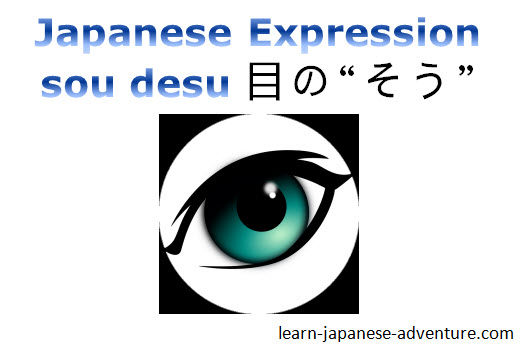- Home
- Intermediate Lessons
- Japanese Expression sou desu
Japanese Expression sou desu 目の"そう" -
Intermediate Lessons: 19
In this lesson, you are going to learn another Japanese expression そうです (sou desu), also known as 目の"そう" (me no "sou").

This is different from the other expression sou desu, or known as 耳の"そう" (mimi no "sou") you have learned in lesson 10.
Difference between 耳の"そう" and 目の"そう"
そうです (sou desu) in 耳の"そう" (mimi no "sou") is used to convey the message that you obtained from another information source, either you have heard from someone or you have read it somewhere.
Whereas for そうです (sou desu) in 目の"そう" (me no "sou"), it means "It looks like ~"or "It seems ~". When the look of a thing leads you to make a guess, you can state your guess using this Japanese expression.
You make the guess after looking at the appearance of a thing although it has not confirmed for a fact. The "thing" here can also be a person, a place, a scene, etc.
Sentence Patterns
Let's check out the sentence patterns...
| Verb (stem of ます form) そうです | |
| い-adj (~ |
(present/affirmative) |
| い-adj (~ |
(present/negative) |
| な-adj そうです | (present/affirmative) |
| な-adj ではなさそうです | (present/negative) |
Exception: いい → よさ、 ない → なさ
I will discuss about そうです with verbs later. For now, let's concentrate on the そうです with adjectives.
Examples for Adjective Present Affirmative Sentences
For example, you saw a fat lady walking across the street. She looks like a kind person judging from her appearance. How do you describe her using the above sentence patterns?
- あの女の人は親切そうです。 / あの女の人は優し
いそうです。
ano onna no hito wa shinsetsu sou desu / ano onna no hito wa yasashi sou desu
Meaning: That lady looks like a kind person.
You don't know about that fat lady and you are just describing her from her appearance. Therefore you can use this Japanese expression sou desu to describe her.
However, if that lady is someone whom you know very well and she has a kind heart, you have to say
- あの女の人は親切です。 / あの女の人は優しいです。
ano onna no hito wa shinsetsu desu / ano onna no hito wa yasashii desu
Meaning: That lady is a kind person.
How about her body size? In this case, you cannot say something like ふとっていそうです (futottei sou desu) which means she looks fat literally.
Why? Because she is (obviously) fat from her appearance. That's a fact, not a guess. Therefore you cannot use the Japanese expression sou desu sentence pattern here.
Examples for Adjective Present Negative Sentences
For example, a new teacher came to your school today. She looks very fierce from her appearance. How do you use the Japanese expression sou desu to describe the new teacher?
- 新しい先生は親切ではなさそうです。 / 新しい先生は優しくなさそうです。
atarashii sensei wa shinsetsu dewa nasa sou desu / atarashii sensei wa yasashiku nasa sou desu
Meaning: The new teacher looks like an unkind (strict) person.
Examples for Describing the Weather
Assuming that you are looking at the news on the television. The news shows that Hokkaido is currently covered with heavy snow. It looks really cold there.
On the other hand, the news also shows that people are swimming at the beach under the hot sun at Okinawa. It looks very hot there. How do you describe these two scenes?
- 北海道は寒そうです。
hokkaidou wa samu sou desu
Meaning: It seems cold in Hokkaido.
- 沖縄は暑そうです。
okinawa wa atsu sou desu
Meaning: It seems hot in Okinawa.
Unless you have been to the two places personally and know the weather there, you can only use Japanese expression sou desu sentence pattern.
Examples for Describing a Place
Assuming that you are looking at the pictures of 2 different towns. Town A looks very quiet and Town B looks very crowded and lively. How do you describe them?
- 町 A は静かそうです。
machi A wa shizuka sou desu
Meaning: Town A looks like a quiet town.
- 町 B は賑やかそうです。
machi B wa nigiyaka sou desu
Meaning: Town B looks like a lively town.
Examples using the Exceptions
There are 2 exceptions where いい has to change to よさそうです and ない has to change to なさそうです.
You have seen in the earlier examples on how to use なさそうです (nasa sou desu). Let's see some examples using よさそうです (yosa sou desu).
Assuming that you have looked at the cover of a book and read some description on the cover. It looks like a good book. How do you describe it?
- この本はよさそうです。
kono hon wa yosa sou desu
Meaning: This looks like a good book.
Assuming that you are looking at a guy who looks very smart from his appearance and the way he is talking. How do you describe him?
- あの人は頭がよさそうです。
ano hito wa atama ga yosa sou desu
Meaning: That person looks like a smart guy.
Describing Other Person's Emotional Feelings
When you are describing your own emotional feelings, you can use adjectives like:
| Kanji | Romaji | Meaning |
| 嬉しい | ureshii | Happy |
| 悲しい | kanashii | Sad |
| 楽しい | tanoshii | Enjoyable |
| 寂しい | sabishii | Lonely |
| 心配 | shinpai | Worry |
| 怖い | kowai | Scary |
| 幸せ | shiawase | Happy/Blessed |
| つまらない | tsumaranai | Boring |
However, in Japanese, when come to describing other person's emotional feelings, you definitely have to describe using the Japanese expression sou desu.
The reason is that you can never know how the other person feels, even if the person tells you how he/she feels (he/she may be lying to you). You can only guess judging from his/her expression.
For example when you are describing your friend's emotional feelings using the above adjectives, you may say:
| Kanji | Romaji | Meaning |
| 彼は嬉しそうです | kare wa ureshi sou desu | He looks happy |
| 彼は悲しそうです | kare wa kanashi sou desu | He looks sad |
| 彼は楽しそうです | kare wa tanoshi sou desu | He looks like he's enjoying |
| 彼は寂しそうです | kare wa sabishi sou desu | He looks lonely |
| 彼は心配そうです | kare wa shinpai sou desu | He looks worried |
| 彼は怖そうです | kare wa kowa sou desu | He looks scared |
| 彼は幸せそうです | kare wa shiawase sou desu | He looks blessed |
| 彼はつまらなそうです | kare wa tsumarana sou desu | He looks bored |
Be careful not to confuse the meaning of 彼はつまらなそうです (kare wa tsumarana sou desu) and the meaning of 彼はつまらないです (kare wa tsumaranai desu).
The former means that you are guessing that he feels bored by looking at his expression. The latter means that he is a boring person.
Moreover, つまらない (tsumaranai) is an い-adj (i-adj), not a ない-form of a verb. Therefore you cannot say something like 彼はつまらなさそうです (kare wa tsumaranasa sou desu).
Japanese Expression そうです (sou desu) with Verbs
For Japanese expression そうです (sou desu) with Verbs, you are guessing what is going to happen soon from what you see. The sentence patterns are as shown below...
| Verb (stem of ます form) そうです | (present/affirmative) |
| Verb (stem of ます form) そうもありません | (present/negative) |
For example, if the sky is full of dark clouds and is getting darker, you guess what is going to happen soon by saying...
- もうすぐ雨が降りそうです。
mousugu ame ga furi sou desu
Meaning: It looks like it's going to rain soon.
What if there is no cloud in the sky and is sunny. There is no sign of raining. How do you guess the weather?
- 雨が降りそうもありません。
ame ga furi soumo arimasen
Meaning: It looks like it's not going to rain.
If the rain is getting smaller and the sky is getting clearer. You can say...
- 雨が止みそうです。
ame ga yami sou desu
Meaning: It looks like the rain is going to stop.
But if it's a heavy downpour and there's no sign of the rain stopping, you can then say...
- 雨が止みそうもありません。
ame ga yami soumo arimasen
Meaning: It looks like the rain is not going to stop.
More Examples
- あの荷物は落ちそうです。
ano nimotsu wa ochi sou desu
Meaning: It looks like that luggage is going to fall down.
- 鞄の紐が切れそうです。
kaban no himo ga kire sou desu
Meaning: It looks like the strap of my bag is going to break off.
- シャンプーが無くなりそうです。
shanpu- ga nakunari sou desu
Meaning: It looks like the shampoo is going to run out.
- もうすぐ桜が咲きそうです。
mousugu sakura ga saki sou desu
Meaning: It looks like the cherry trees are going to be in bloom soon.
- これから寒くなりそうです。
korekara samukunari sou desu
Meaning: It seems like it will be getting colder from now on.
Summary
In summary, this Japanese expression そうです (sou desu) can be used if you are making a guess from the appearance of the "thing" you are describing.
But if you have already known it to be a fact, it cannot be used.
Related Page
Lesson 10: Expression for Hearsay 耳の"そう".
Best Deal of the Year! Get 68% OFF Lifetime Premium! Ends on 13 Dec 2025
Click Here to Get 68% OFF Lifetime Premium and be on the fast track to fluency in Japanese.
The link above is an affiliate link, which means that I would earn a commission (at no extra cost to you) if you do end up purchasing the related learning course.
Buy me a coffee









Facebook Comments
Don’t see the comments box? Log in to your Facebook account, give Facebook consent, then return to this page and refresh it.